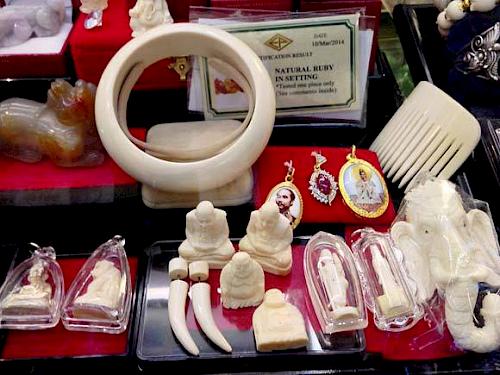Thailand must address illegal ivory trade or could face sanctions: CITES
Geneva, Switzerland, 25th July 2014—An intercessional meeting of the Convention on International Trade in Endangered Species of Wild Fauna and Flora (CITES) ended earlier this month with Thailand agreeing to a strict timetable of actions to address the illegal ivory trade or face the threat of trade sanctions.

Thailand was given until 30th September this year to submit a revised national ivory action plan which must include a number of specified measures. They include: legislative changes, such as the inclusion of the African Elephant as a “protected species” under the country’s Wildlife Act, to allow for the effective control of domestic ivory trade, with strict penalties for illegal possession or illegal domestic trade of ivory; establishment of comprehensive registration systems for domestic ivory and for licensed ivory traders; better monitoring and control of ivory traders, as well as law enforcement efforts against illegal trade.
The progress made by Thailand will be assessed by CITES on 31st March 2015 and if found lacking, members of the CITES Standing Committee will be invited to vote on whether punitive trade sanctions should be imposed against the country.
The impact of trade sanctions on the national economy would be significant: all trade in CITES-listed species would be precluded. For example, the lucrative exports of orchids by the country’s horticultural sector would be effectively stopped, resulting in a loss of more than USD 80 million in annual sales based on the 2013 value of this trade.
“The message from CITES is loud and clear: Thailand must act or face the consequences,” said Sabri Zain, Director of Policy at TRAFFIC.
Thailand was one of eight countries instructed by CITES in 2013 to prepare national ivory action plans. The meeting earlier this month was the first opportunity for government Parties to assess their progress in doing so, with Thailand receiving the most criticism for failure to make significant progress.
A week before the meeting, TRAFFIC had released a report on Thailand’s ivory market, which found the availability of ivory on sale in Bangkok had tripled in the year since the country pledged to eradicate its domestic ivory market.
The packed CITES Standing Committee agenda also discussed the progress made by a number of countries at the centre of the rhino poaching crisis. Viet Nam reported Prime Minister Nguyen Tan Dung had issued a top-level Directive to his line ministries prioritizing enforcement at all levels, and across ministries, to combat poaching and trafficking of African elephant ivory and rhino horn.
Meanwhile Mozambique emerged as a country of particular concern over its failure to tighten legislation surrounding rhino horn trafficking and its role as both an operational base for poachers acting in South Africa and as a key transit country for horn leaving Africa.
South Africa’s Department of Environmental Affairs on 10th July reported the rhino poaching toll in 2014 stood at 558 animals, 351 of them in Kruger National Park alone, and at current rates the numbers look certain to pass last year’s record total of 1004.
A TRAFFIC co-authored report (PDF here) into the progress made by range States in implementing measures to protecting the four species of Asian Big Cats (Tiger, Lion, Leopard and Snow Leopard) was also tabled at the meeting. It provided CITES with the largest body of work and information on illegal trade in these species since the late 1990s and raised a number of issues. Most of the report’s recommendations were adopted, including improved legislation to protect and animals and enhancing the international co-operation between range States. A working group has been established to study the information provided, identify priority issues of concern that need to be addressed and provide appropriate recommendations to the next intercessional CITES Standing Committee meeting in 2015.
Another hot topic of debate was the issue of what to do with the accumulated stockpiles of Malagasy rosewoods. These highly valuable timber species have been illegally felled from protected areas, particularly in the north of Madagascar and there had been moves to seek permission to auction them off, but the CITES Standing Committee considered a full inventory was a pre-requisite before any sale could be considered.
There was also important clarification on some of the measures needed before the listing of seven shark and two manta rays species, adopted into the CITES Appendices in March 2013, come into force in September this year. The delay had always been planned to give national governments time to adjust to the new measures.
Parties were also informed of a number to tools available to assist countries in the implementation of the shark listings, including a method developed by TRAFFIC to provide guidance for assessing whether trade will have a negative impact on a particular species – a so-called “Non-detriment Finding” (NDF) and a pre-requisite before a CITES certificate can be issued to allow trade. TRAFFIC has also helped develop a method for making a rapid management-risk assessment for fish species through its application to sharks, and encouraged CITES parties to adopt both these new tools.
“This was overall a very positive meeting and carried on where CITES left off in March 2013, with the Convention demonstrating it has the structure and mechanisms to help bring in the essential measures needed to protect the world’s wildlife,” said Zain.

